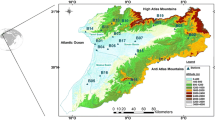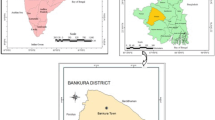Abstract
Many climate studies in Mozambique have clearly identified signals of climate change, especially changes in the extreme temperatures. Regarding precipitation, there is still a gap on the knowledge of how it is behaving due to both internal and external factors in the climate system. In this study, we have investigated the existence of long-term correlations and trend in time series of precipitation. Two databases were used for this purpose: in situ observations along the period of 1960–2020 and the Climate Hazards group InfraRed Precipitation with Stations (CHIRPS) dataset, along the period from 1981 to 2021. We have applied the rescaled-range analysis and the detrended fluctuation analysis for long memory investigation, and the linear regression and Mann-Kendall methods for trend analysis. Results have shown the existence of long memory in precipitation in most parts of Mozambique, being stronger in the southern and central regions and weakening toward the north of the country. On the other hand, significant trend signals of precipitation were detected in some isolated areas of Mozambique, presenting an increase in some regions such as the southern part of Manica and eastern of Inhambane provinces and a decrease in other regions such as the coastal areas of Zambezia and Nampula. These findings indicate that the probability of a random occurrence of precipitation is minimal, and the observed trends are likely to continue for a long period in future. Dry land agriculture should be prepared to adapt to new precipitation regime in the regions mentioned hereof.






Similar content being viewed by others

Availability of data and material
In situ datasets analyzed during this study can be obtained from the National Institute of Meteorology under specific request, and CHIRPS datasets are publicly available and can freely be downloaded from the link https://data.chc.ucsb.edu/products/CHIRPS-2.0/. Code scripts and data generated from the study (gap filled station data, figures, etc.) are available from the corresponding author on reasonable request.
Notes
SARMAX(p, q)(P, Q, m) is actually an ARMA(p, q) model, except that SARMAX takes into account the seasonal component of order (P, Q, m) in the time series, and an eXogenous variable.
ARMA model is the combination of Auto-Regressive AR(p) and Moving Average MA(q) models.
CMIP5 - Coupled Model Intercomparison Project Phase 5.
RCP4.5 is an acronym designated to represent the intermediate scenario of greenhouse gas emission policy.
References
Ambrosino C, Chandler RE, Todd MC (2011) Southern African monthly rainfall variability: an analysis based on generalized linear models. J Clim 24:4600–4617. https://doi.org/10.1175/2010JCLI3924.1
Araneda-Cabrera RJ, Bermudez M, Puertas J (2021) Revealing the spatio-temporal characteristics of drought in Mozambique and their relationship with large-scale climate variability. J Hydrol: Regional Studies 38:100938. https://doi.org/10.1016/j.ejrh.2021.100938
Arias PA, Bellouin N, Coppola E et al (2021) Technical summary. In: Masson-Delmotte V, Zhai P, Pirani A et al (eds) Climate change 2021: the physical science basis. Contribution of working group I to the Sixth Assessment Report of the Intergovernmental Panel on Climate Change. Cambridge University Press, pp 33–144. https://doi.org/10.1017/9781009157896.002
Barimalala R, Blamey RC, Desbiolles F, Reason CJC (2020) Variability in the Mozambique Channel trough and impacts on southeast African rainfall. J Climate 33:749–765. https://doi.org/10.1175/JCLI-D-19-0267.1
Beran J (1994) Statistics for long-memory processes. 1st edn. Routledge, New York, pp 315. eBook ISBN: 9780203738481. https://doi.org/10.1201/9780203738481
Caballero R, Jewson S, Brix A (2002) Long memory in surface air temperature: detection, modeling, and application to weather derivative valuation. Clim Res 21(2):127–140. https://doi.org/10.3354/cr021127
Fu G, Charles SP, Yu J, Liu C (2009) Decadal climatic variability, trends, and future scenarios for the North China Plain. J Climate 22:2111–2123. https://doi.org/10.1175/2008JCLI2605.1
Funk C, Peterson P, Landsfeld M, Pedreros D, Verdin J, Shukla S, Husak G, Rowland J, Harrison L, Hoell A, Michaelsen J (2015) The climate hazards infrared precipitation with stations - a new environmental record for monitoring extremes. Scientific Data 2:150066. https://doi.org/10.1038/sdata.2015.66
Gan TY (1998) Hydroclimatic trends and possible climatic warming in the Canadian Prairies. Water Resour Res 34(11):3009–3015. https://doi.org/10.1029/98wr01265
Hartmann DL, Klein Tank AMG, Rusticucci M et al (2013) Observations: atmosphere and surface supplementary material. In: Stocker TF, Qin D, Plattner G-K et al (eds) Climate Change 2013: The Physical Science Basis. Contribution of Working Group I to the Fifth Assessment Report of the Intergovernmental Panel on Climate Change. Cambridge University Press, cap. 2SM. www.climatechange2013.org. Accessed 26 June 2021
Heumann C, Schomaker M, Shalabh (2016) Introduction to statistics and data analysis. Springer International Publishing, Control Number: 2016955516, Switzerland, pp. 451. ISBN 978-3-319-46162-5. https://doi.org/10.1007/978-3-319-46162-5
Hirsch RM, Slack JR, Smith RA (1982) Techniques of trend analysis for monthly water quality data. Water Resour Res 18(1):107–121. https://doi.org/10.1029/wr018i001p00107
Hurst H (1951) Long term storage capacity of reservoirs. Trans Am Soc Civ Eng 116(1):770–799. https://doi.org/10.1061/TACEAT.0006518
IPCC (2014) Climate change 2014: synthesis report. In: Pachauri RK, Meyer LA (eds) Contribution of working groups I, II and III to the fifth assessment report of the intergovernmental panel on climate change. IPCC, Geneva, Switzerland, pp 151. https://doi.org/10.1017/CBO9781107415324.008
IPCC (2021) Climate change 2021: the physical science basis. In: [Masson-Delmotte V, Zhai P, Pirani A et al (eds) Contribution of working group I to the sixth assessment report of the intergovernmental panel on climate change. Cambridge University Press, Cambridge, UK, NY, USA, pp 2391. https://doi.org/10.1017/9781009157896
Kantelhardt JW, Koscielny-Bunde E, Rego HHA, Havlin S, Bunde A (2001) Detecting long-range correlations with detrended fluctuation analysis. Physica A 295:441–454. https://doi.org/10.1016/s0378-4371(01)00144-3
Kendall MG (1975) Rank correlation methods. 4th edn. Charles Griffin, pp 212. ISBN: 0852641990 9780852641996
Lim Kam Sian KTC, Wang J, Ayugi BO, Nooni IK, Ongoma V (2021) Multi-decadal variability and future changes in precipitation over southern Africa. Atmosphere 12:742. https://doi.org/10.3390/atmos12060742
Machaieie HA, Silva CG, de Oliveira EN, Júnior HIT, de Almeida HA (2020) Variability and trends of precipitation in Quelimane, Central Mozambique, and their relation to El Niño southern oscillation. Journal of Geoscience and Environment Protection 8:1–16. https://doi.org/10.4236/gep.2020.87001
Mandelbrot B (1967) How long is the coast of Britain? Statistical self-similarity and fractional dimension. Science 156(3775):636–638. https://www.jstor.org/stable/1721427. Accessed 01 May 2021
Mandelbrot B, Wallis J (1969) Computer experiments with fractional Gaussian noises. Part 2, Water Resour Res 5(1):242–259. https://doi.org/10.1029/WR005i001p00242
Mann HB (1945) Nonparametric tests against trend. Econometrica 13(3):245–259. https://doi.org/10.2307/1907187
Manuel L, Tostão E, Vilanculos O, Mandlhate G, Hartley F (2020) Economic implications of climate change in Mozambique. SA-TIED Working Paper 136, p 21. https://ceppag.uem.mz/images/pdf/SA_TIED_WP_136.pdf. Accessed 13 April 2023
Mavume A, Rydberg L, Rouault M, Lutjeharms J (2009) Climatology and landfall of tropical cyclones in the south-west Indian Ocean. Western Indian Ocean J. Mar. Sci. 8(1):15–36. https://doi.org/10.4314/wiojms.v8i1.56672
Mavume AF, Banze BE, Macie OA, Queface AJ (2021) Analysis of climate change projections for Mozambique under the representative concentration pathways. Atmosphere 12(5):588. https://doi.org/10.3390/atmos12050588
McSweeney C, New M, Lizcano G, Lu X (2010) The UNDP climate change country profiles improving the accessibility of observed and projected climate information for studies of climate change in develo** countries. Bull Am Meteorol Soc 91(2):157–166. https://doi.org/10.1175/2009BAMS2826.1
Meals DW, Spooner J, Dressing SA, Harcum JB (2011) Statistical analysis for monotonic trends. Tech Notes 6. U.S. Environmental Protection Agency by Tetra Tech, Inc., Fairfax, VA, p 23. https://www.epa.gov/polluted-runoff-nonpoint-source-pollution/nonpoint-source-monitoringtechnical-notes. Accessed 20 March 2022
Peng CK, Buldyrev SV, Havlin S, Simons M, Stanley HE, Goldberger AL (1994) Mosaic organization of DNA nucleotides. Phys Rev E 49(2):1685–1689. https://doi.org/10.1103/physreve.49.1685
Pomposi C, Funk C, Shukla S, Harrison L, Magadzire T (2018) Distinguishing southern Africa precipitation response by strength of El Niño events and implications for decision-making. Environ. Res. Lett. 13:074015. https://doi.org/10.1088/1748-9326/aacc4c
Ponkina E, Illiger P, Krotova O, Bondarovich A (2021) Do ARMA models provide better gap filling in time series of soil temperature and soil moisture? The case of arable land in the Kulunda Steppe. Russia. Land 10(6):579. https://doi.org/10.3390/land10060579
Qiu M, Yuan N, Yuan S (2020) Understanding long-term memory in global mean temperature: an attribution study based on model simulations. Atmos Ocean Sci Letters 13(5):485–492. https://doi.org/10.1080/16742834.2020.1778418
Queiroz A, Manjate T, Maure G, Mosquito DP (2007) Avaliação da vulnerabilidade dos parâmetros climáticos e projeção de cenários climúticos. Maputo - Moçambique, Technical report, p 39
Reason C, Jagadheesha D (2005) A model investigation of recent ENSO impacts over Southern Africa. Meteorog Atmos Phys 89:181–205. https://doi.org/10.1007/s00703-005-0128-9
Salite D, Poskitt S (2019) Managing the impacts of drought: the role of cultural beliefs in small-scale farmers’ responses to drought in Gaza Province, southern Mozambique. International Journal of Disaster Risk Reduction 41. https://doi.org/10.1016/j.ijdrr.2019.101298
Sen PK (1968) Estimates of the regression coefficient based on Kendall’s tau. J Am Stat Assoc 63(324):1379–1389. https://doi.org/10.1080/01621459.1968.10480934
Seneviratne SI, Zhang X, Adnan M, Badi W, Dereczynski C, Di Luca A et al (2021) Weather and climate extreme events in a changing climate. In: Masson-Delmotte V, Zhai P, Pirani A et al (eds) Climate Change 2021: The Physical Science Basis. Contribution of Working Group I to the Sixth Assessment Report of the Intergovernmental Panel on Climate Change. Cambridge University Press, Cambridge, United Kingdom and New York, NY, USA, pp 1513–1766. https://doi.org/10.1017/9781009157896.013
Taylor CH, Loftis JC (1989) Testing for trend in lake and ground water quality time series. Water Resour Bull 25(4):715–726. https://doi.org/10.1111/j.1752-1688.1989.tb05385.x
Ussalu JLM, Bassrei A (2021) Climate dynamics of southern region of Mozambique: statistics and Fourier analysis. Braz J Climatology 29:134–156. https://doi.org/10.5380/rbclima.v29i0.75088
Vera-Valdés JE (2021) Temperature anomalies, long memory, and aggregation. Econometrics 9:9. https://doi.org/10.3390/econometrics9010009
Vyushin DI, Kushner PJ (2008) Power-law and long-memory characteristics of the atmospheric general circulation. J Climate 22:2890–2904. https://doi.org/10.1175/2008JCLI2528.1
Xu ZX, Li JY, Liu CM (2007) Long-term trend analysis for major climate variables in the Yellow River basin. Hydrol Process 21(14):1935–1948. https://doi.org/10.1002/hyp.6405
Yu Y, Zou S, Whittemore D (1993) Non-parametric trend analysis of water quality data of rivers in Kansas. J Hydrol 150(1):61–80. https://doi.org/10.1016/0022-1694(93)90156-4
Yuan N, Fu Z, Liu S (2014) Extracting climate memory using fractional integrated statistical model: a new perspective on climate prediction. Scientific Reports 4(6577):1–10. https://doi.org/10.1038/srep06577
Acknowledgements
The authors would like to thank the National Institute of Meteorology (INAM) and the Climate Hazards group InfraRed Precipitation with Stations (CHIRPS) for providing the climate data used in this study. A special thanks to Mr. Guelso Mauro Manjate for his kind facilitation on the acquisition process of INAM’s data.
Author information
Authors and Affiliations
Contributions
JLMU proposed the objectives and most of the methodology, compiled the data, performed the data analysis, generated the figures, and wrote and reviewed the manuscript. AB proposed additional methodology, commented the results, and reviewed the manuscript.
Corresponding author
Ethics declarations
Ethics approval and consent to participate
Not applicable.
Consent for publication
Both authors gave explicit consent for the publication of this article.
Conflict of interest
The authors declare no competing interests.
Additional information
Publisher's Note
Springer Nature remains neutral with regard to jurisdictional claims in published maps and institutional affiliations.
Rights and permissions
Springer Nature or its licensor (e.g. a society or other partner) holds exclusive rights to this article under a publishing agreement with the author(s) or other rightsholder(s); author self-archiving of the accepted manuscript version of this article is solely governed by the terms of such publishing agreement and applicable law.
About this article
Cite this article
Ussalu, J.L.M., Bassrei, A. Long memory and trend in time series of precipitation in Mozambique. Theor Appl Climatol 154, 643–659 (2023). https://doi.org/10.1007/s00704-023-04579-x
Received:
Accepted:
Published:
Issue Date:
DOI: https://doi.org/10.1007/s00704-023-04579-x



